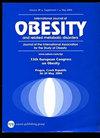Prospective prediction of childhood body mass index trajectories using multi-task Gaussian processes
IF 4.2
2区 医学
Q1 ENDOCRINOLOGY & METABOLISM
引用次数: 0
Abstract
Body mass index (BMI) trajectories have been used to assess the growth of children with respect to their peers, and to anticipate future obesity and disease risk. While retrospective BMI trajectories have been actively studied, models to prospectively predict continuous BMI trajectories have not been investigated. Using longitudinal BMI measurements between birth and age 10 y from a mother-offspring cohort, we leveraged a multi-task Gaussian process approach to develop and evaluate a unified framework for modeling, clustering, and prospective prediction of BMI trajectories. We compared its sensitivity to missing values in the longitudinal follow-up of children, compared its prediction performance to cubic B-spline and multilevel Jenss-Bayley models, and used prospectively predicted BMI trajectories to assess the probability of future BMIs crossing the clinical cutoffs for obesity. MagmaClust identified 5 distinct patterns of BMI trajectories between 0 to 10 y. The method outperformed both cubic B-spline and multilevel Jenss-Bayley models in the accuracy of retrospective BMI trajectories while being more robust to missing data (up to 90%). It was also better at prospectively forecasting BMI trajectories of children for periods ranging from 2 to 8 years into the future, using historic BMI data. Given BMI data between birth and age 2 years, prediction of overweight/obesity status at age 10 years, as computed from MagmaClust’s predictions exhibited high specificity (0.94), negative predictive value (0.89), and accuracy (0.86). The accuracy, sensitivity, and positive predictive value of predictions increased as BMI data from additional time points were utilized for prediction. MagmaClust provides a unified, probabilistic, non-parametric framework to model, cluster, and prospectively predict childhood BMI trajectories and overweight/obesity risk. The proposed method offers a convenient tool for clinicians to monitor BMI growth in children, allowing them to prospectively identify children with high predicted overweight/obesity risk and implement timely interventions.

利用多任务高斯过程对儿童体重指数轨迹进行前瞻性预测。
背景:身体质量指数(BMI)轨迹已被用于评估儿童相对于同龄人的成长情况,以及预测未来肥胖和疾病风险。虽然对回顾性 BMI 轨迹进行了积极的研究,但对连续性 BMI 轨迹的前瞻性预测模型尚未进行调查:利用母子队列中从出生到 10 岁期间的纵向 BMI 测量值,我们采用多任务高斯过程方法,开发并评估了一个用于建模、聚类和前瞻性预测 BMI 轨迹的统一框架。我们比较了它对儿童纵向随访中缺失值的敏感性,比较了它与立方B-样条模型和多层次Jenss-Bayley模型的预测性能,并使用前瞻性预测的BMI轨迹来评估未来BMI超过肥胖临床临界值的概率:MagmaClust确定了0到10岁之间BMI轨迹的5种不同模式。在回溯 BMI 轨迹的准确性方面,该方法优于立方 B-样条模型和多层次 Jenss-Bayley 模型,同时对缺失数据的稳健性更高(高达 90%)。此外,该方法还能利用历史 BMI 数据,更好地预测儿童未来 2 至 8 年的 BMI 轨迹。根据出生至 2 岁期间的 BMI 数据,MagmaClust 预测计算出的 10 岁时超重/肥胖状况具有较高的特异性(0.94)、阴性预测值(0.89)和准确性(0.86)。随着更多时间点的 BMI 数据被用于预测,预测的准确性、灵敏度和阳性预测值也随之增加:MagmaClust 提供了一个统一的、概率性的、非参数框架,用于建模、聚类和前瞻性地预测儿童 BMI 轨迹和超重/肥胖风险。所提出的方法为临床医生监测儿童体重指数的增长提供了一种便捷的工具,使他们能够前瞻性地识别预测超重/肥胖风险较高的儿童,并及时实施干预措施。
本文章由计算机程序翻译,如有差异,请以英文原文为准。
求助全文
约1分钟内获得全文
求助全文
来源期刊

International Journal of Obesity
医学-内分泌学与代谢
CiteScore
10.00
自引率
2.00%
发文量
221
审稿时长
3 months
期刊介绍:
The International Journal of Obesity is a multi-disciplinary forum for research describing basic, clinical and applied studies in biochemistry, physiology, genetics and nutrition, molecular, metabolic, psychological and epidemiological aspects of obesity and related disorders.
We publish a range of content types including original research articles, technical reports, reviews, correspondence and brief communications that elaborate on significant advances in the field and cover topical issues.
 求助内容:
求助内容: 应助结果提醒方式:
应助结果提醒方式:


